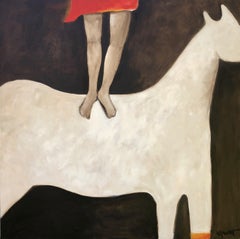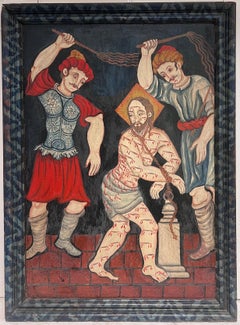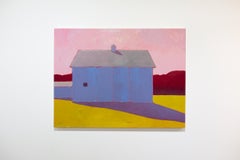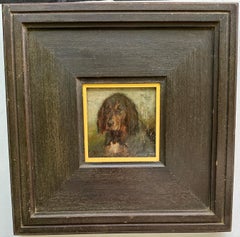Signed watercolour on paper landscape by American post impressionist painter Maurice Brazil Prendergast. The work depicts children playing on the beach in Saint Malo, France as boats sail in the blue sea and white clouds role through the sky overhead. This work has remained in the Prendergast family for 3 generations and depicts a rare view of Saint-Malo executed during Prendergast's visit to the french coastal town in 1907
Signature:
Signed lower left
Dimensions:
Framed: 21"x22"
Unframed: 13'x14"
Proveance:
The collection of Charles Prendergast (1863-1948)
The collection of Eugénie Prendergast-Van Kemmel (1895-1994) -wife and inheritor of the estate of Charles Prendergast
The collection of Henri Van Kemmel (Lille, 1903-1963) - cousin of Eugenie Prendergast
- Madame Henri Van Kemmel
Maurice Prendergast came with his family to Boston in 1861. Working in a textile store, Maurice Prendergast was at first self-taught in painting, making souvenir cards and shop signs. He went to Britain in 1886, then to Paris in 1891 and registered at the Académie Julian with Jean-Paul Laurens, Benjamin-Constant, and Charles Blanc as teachers, working also with Gustave Courtois at the Académie Colarossi. More importantly he saw the Impressionists’ paintings and the Nabis at the Galerie Durand-Ruel. He returned to the United States in 1895, settling in Winchester (Massachusetts) and went frequently to New York. In 1898 he again went to Europe where he stayed until 1900, visiting Paris, Florence, Siena, Rome, Capri, and Venice, where he spent six months. Between 1907 and the beginning of World War I he went again four times to Europe but never returned there after the war. In New York where he finally settled, with William Glackens, Robert Henri, and John Sloan among others, Prendergast was one of the members ofThe Eight, gathered by Robert Henri to counter the pervading academicism. The group exhibited in 1908 at the Macbeth Galleries and took part in the Armory Show of 1913. After that Prendergast did not exhibit again with the group. In 1914 he left Boston definitively for New York.
Prendergast was in his thirties before he began to devote himself to painting. In his late beginnings he painted in the open air as the Impressionists did, mainly in watercolours with clear brushstrokes and an elegant virtuosity recalling his then admiration for James Whistler and Claude Monet. Between 1892 and 1905 he carried out two hundred monotypes, a technique of which he was the undisputed master in America at that time and which expressed the influence of Japanisme. During his stays in France he painted views of Paris, but also Brittany and Normandy. In this period, in 1896, he was chosen to illustrate My Lady Nicotine by Matthew Barrie. During his third stay in Europe, from 1898 to 1900, he painted in Paris, at Saint-Malo, and mainly in Venice, where, influenced by Vittore Carpaccio he introduced brightly coloured banners into his animated compositions. In oils he painted slowly, touching up his paintings by superimposed brushstrokes, sometimes over several years. He chose to use the divided stroke in an early period, a technique which had similarities with Post-Impressionism. After his travels in Europe and his discovery of Paul Cézanne, he evolved in the direction of the neo-Impressionism of Georges Seurat, placing little dots of colours with a knife, then of the Nabis and even later Fauvism, painting large brushed surfaces in bright colours. After 1899, his Ponte della Paglia in Venice freed itself from strict divisionism, adopting the dense composition in vertically superimposed planes of the Nabis. Like the members of the group of eight, he took his subjects from the daily life of ordinary people, in scenes in the parks or on the beaches of New England, picnics or sometimes circuses. Nevertheless the happy vision that he had of the world separated him strongly from the evolution that led his companions to paint the most miserable and populous milieus, which gave them the name of The Ashcan School. His compositions are arranged in surfaces superimposed vertically, without depth; while the Impressionists and Post-Impressionists were influenced by the layout of Japanese prints, Prendergast was inspired more by Persian miniatures. The decorative elements and the build-up of characters in crowds are placed frontally, like garlands on a tapestry, particularly as he seeks a texture effect, covered entirely by the subject without any empty spaces. His attraction to colours caused him to research all the motifs that he introduced into these compositions: umbrellas, parasols, balloons, draperies. In 1911–1912, he experimented with pastel and treated new subjects, nudes and still-lifes. After 1913, in sympathy with the Symbolists, he put nude figures and everyday characters side by side in the same composition. In his last years, and above all in the watercolours, he discarded the divided stroke and applied larger brushstrokes, similar to the technique of Henri Matisse. Fidelity to the leisurely settings and elegant grooming of the period gave his works, apart from their artistic value, a charming sociological aspect. Singular, almost marginal in his time, his paintings stand out by the density of their composition, in form and colouring, characterised by the accumulation of detail, minutiae of scenery, the serried ranks of people that animate them, the chromatic polyphony of elegance, umbrellas, parasols, and flags. He is a complete painter, particularly generous, who would never be happy to provide only samples of his art. Following Whistler and Mary Cassatt, Maurice Prendergast is one of the most interesting and original Post-Impressionist American painters, and perhaps marks exactly the boundary between the 19th and the 20th centuries.
He was considered to be an ‘old master’ from 1920 on, and his works appeared in very many exhibitions of modern American painting. He had his first solo exhibition in 1897 at the Chase Gallery of Boston, where his works were noticed by Madame Montgomery Sears, who made a collection, taking the advice of Mary Cassatt. In 1915 six paintings and watercolours exhibited at the Carroll Gallery of New York established his success and drew the great collectors to him, among whom were Albert Barnes and John Quinn.
Group Exhibitions
1974, Ten Americans, Andrew Crispo Gallery, New York
1976, Art of Impulse and Color, University of Maryland Art Gallery, College Park (Maryland)
1982, American Impressionists, Smithsonian Institution, Washington, DC (also presented at the Musée du Petit Palais, Paris)
1999, Town and Country: American Artists, 1870–1920 (Ville et campagne: les artistes américains, 1870–1920), Musée d’Art Américain, Giverny
2002, Japonisme in America: Works on Paper, 1880–1930 (Le Japonisme en Amérique: œuvres sur papier, 1880–1930), Musée d’Art Américain/Terra Foundation for the Arts, Giverny
2007, American Impressionists: Painters of Light and the Modern Landscape, Phillips Collection, Washington, DC
2008, Coming of Age: American Art 1850–1950, Paintings from the Addison Gallery of American Art, Massachusetts, Dulwich Picture Gallery, London
2008, Portrait of a Lady: Paintings and Photographs of American Women in France 1870–1915, Musée des Beaux-Arts, Bordeaux
Solo Exhibitions
1934, Maurice Prendergast Memorial Exhibition, Whitney Museum of American Art, New York
1938, Retrospective Exhibition of the Work of Maurice and Charles Prendergast, Addison Gallery of American Art, Andover, MA
1960, Maurice Prendergast, 1859–1924, Museum of Fine Arts, Boston
1990, Art Institute of Chicago
2009, Prendergast in Italy, Peggy Guggenheim Collection, Venice
Museum and Gallery Holdings
Andover, MA (Addison Gal. of American Art): At the Shore, St. Malo No. 1 and 2 (c. 1907, watercolour and graphite on wove paper, 2 works); Along the Cove (1910–1913, oil on canvas); seven sketches of Paris (1893, oil on wood)
Chicago (AI): In the Park (1918–1919)
Chicago (Terra Foundation for American Art Collection): Festa del redentore (c. 1899, monotype); The
Opera Cloak...




